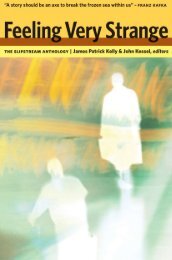The Curse of the Wer.. - Site de Thomas - Free
The Curse of the Wer.. - Site de Thomas - Free
The Curse of the Wer.. - Site de Thomas - Free
You also want an ePaper? Increase the reach of your titles
YUMPU automatically turns print PDFs into web optimized ePapers that Google loves.
WOMEN WHO RUN WITH THE WOLVES<br />
up with <strong>the</strong> inconvenience <strong>of</strong> an ordinary period: ‘I don’t get periods<br />
at all any more. I get a little crampy, and my breasts get sore, and I<br />
break out more than usual — and <strong>the</strong>n instead <strong>of</strong> bleeding, I change.<br />
Which is fine with me.’ 27 In this sense, Kelsey achieves what Germaine<br />
Greer wished for when she wrote that ‘[m]enstruation does not turn<br />
us into raving maniacs or complete invalids; it is just that we would<br />
ra<strong>the</strong>r do without it.’ 28<br />
In <strong>the</strong> context <strong>of</strong> feminist reappraisals <strong>of</strong> attitu<strong>de</strong>s to nature and<br />
<strong>the</strong> body, and <strong>the</strong> Jungian recuperation <strong>of</strong> myths and symbols that has<br />
accompanied this project, <strong>the</strong> attitu<strong>de</strong> to menstruation voiced by Kelsey<br />
and Greer has been challenged by a view that menstruation should be<br />
embraced and celebrated as a quintessential experience <strong>of</strong> womanhood.<br />
<strong>The</strong> Wise Wound: Menstruation and Everywoman (1978) by Penelope<br />
Shuttle (a feminist poet and novelist) and Peter Redgrove (a poet,<br />
scientist and Jungian analyst), for example, focuses on menstruation as<br />
a natural process which should be embraced in or<strong>de</strong>r to ‘enhance <strong>the</strong><br />
growth and powers <strong>of</strong> individual women’ ra<strong>the</strong>r than hid<strong>de</strong>n, drea<strong>de</strong>d<br />
or shunned. 29 Correspondingly, some parallels between lycanthropy<br />
and menstruation have pursued this logic, showing <strong>the</strong> lives <strong>of</strong> female<br />
werewolves to be <strong>de</strong>eply influenced by <strong>the</strong>ir awareness <strong>of</strong> <strong>the</strong>ir own<br />
bodily cycles. In such narratives, lycanthropy is presented as a cause<br />
for celebration or at least as <strong>the</strong> source <strong>of</strong> a richer experience <strong>of</strong> embodiment.<br />
Pat Murphy’s lycanthropic protagonist Nadya, for instance,<br />
is intimately aware <strong>of</strong> <strong>the</strong> moon and its effect upon her body, feeling<br />
its ‘pull in her belly, in her groin’ as it waxes. 30<br />
Angela Carter’s rewriting <strong>of</strong> Little Red Riding Hood in her short<br />
story ‘<strong>The</strong> Company <strong>of</strong> Wolves’ (1979) draws a connection between<br />
lycanthropy and <strong>the</strong> female coming <strong>of</strong> age marked by <strong>the</strong> onset <strong>of</strong> menstruation.<br />
31 In Carter’s narration <strong>of</strong> <strong>the</strong> famous fairy tale, Rosaleen’s<br />
red cloak ‘has <strong>the</strong> ominous if brilliant look <strong>of</strong> blood on snow’, and<br />
her ‘breasts have just begun to swell … her cheeks are an emblematic<br />
scarlet and white and she has just started her woman’s bleeding.’ 32<br />
Virginal white is mingled with red, <strong>the</strong> colour <strong>of</strong> menstrual blood and<br />
<strong>the</strong> harlot, stressing that Red Riding Hood’s encounter with <strong>the</strong> wolf<br />
is a story <strong>of</strong> awakening sexuality.<br />
123





